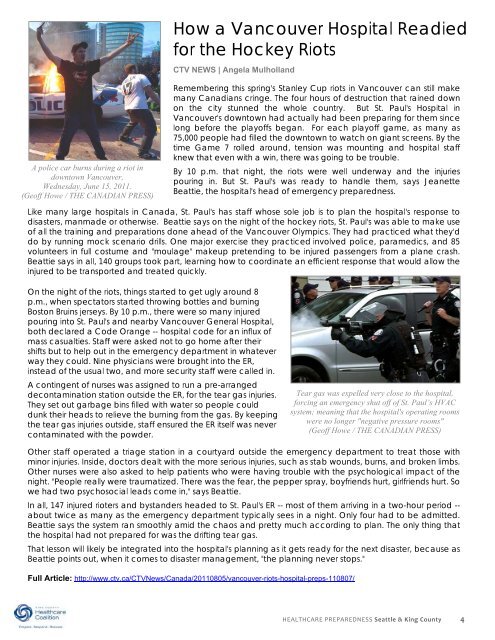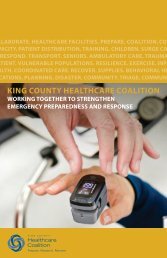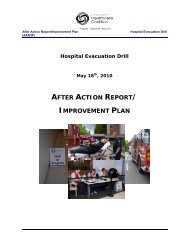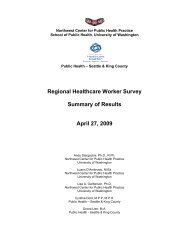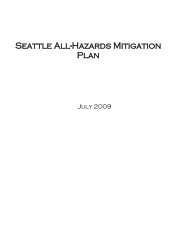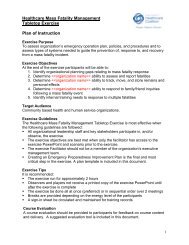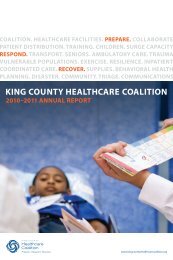Preparedness - KCHC
Preparedness - KCHC
Preparedness - KCHC
Create successful ePaper yourself
Turn your PDF publications into a flip-book with our unique Google optimized e-Paper software.
How a Vancouver Hospital Readied<br />
for the Hockey Riots<br />
CTV NEWS | Angela Mulholland<br />
A police car burns during a riot in<br />
downtown Vancouver,<br />
Wednesday, June 15, 2011.<br />
(Geoff Howe / THE CANADIAN PRESS)<br />
Remembering this spring's Stanley Cup riots in Vancouver can still make<br />
many Canadians cringe. The four hours of destruction that rained down<br />
on the city stunned the whole country. But St. Paul's Hospital in<br />
Vancouver's downtown had actually had been preparing for them since<br />
long before the playoffs began. For each playoff game, as many as<br />
75,000 people had filled the downtown to watch on giant screens. By the<br />
time Game 7 rolled around, tension was mounting and hospital staff<br />
knew that even with a win, there was going to be trouble.<br />
By 10 p.m. that night, the riots were well underway and the injuries<br />
pouring in. But St. Paul's was ready to handle them, says Jeanette<br />
Beattie, the hospital's head of emergency preparedness.<br />
Like many large hospitals in Canada, St. Paul's has staff whose sole job is to plan the hospital's response to<br />
disasters, manmade or otherwise. Beattie says on the night of the hockey riots, St. Paul's was able to make use<br />
of all the training and preparations done ahead of the Vancouver Olympics. They had practiced what they'd<br />
do by running mock scenario drills. One major exercise they practiced involved police, paramedics, and 85<br />
volunteers in full costume and "moulage" makeup pretending to be injured passengers from a plane crash.<br />
Beattie says in all, 140 groups took part, learning how to coordinate an efficient response that would allow the<br />
injured to be transported and treated quickly.<br />
On the night of the riots, things started to get ugly around 8<br />
p.m., when spectators started throwing bottles and burning<br />
Boston Bruins jerseys. By 10 p.m., there were so many injured<br />
pouring into St. Paul's and nearby Vancouver General Hospital,<br />
both declared a Code Orange -- hospital code for an influx of<br />
mass casualties. Staff were asked not to go home after their<br />
shifts but to help out in the emergency department in whatever<br />
way they could. Nine physicians were brought into the ER,<br />
instead of the usual two, and more security staff were called in.<br />
A contingent of nurses was assigned to run a pre-arranged<br />
decontamination station outside the ER, for the tear gas injuries.<br />
They set out garbage bins filled with water so people could<br />
dunk their heads to relieve the burning from the gas. By keeping<br />
the tear gas injuries outside, staff ensured the ER itself was never<br />
contaminated with the powder.<br />
Tear gas was expelled very close to the hospital,<br />
forcing an emergency shut off of St. Paul’s HVAC<br />
system; meaning that the hospital's operating rooms<br />
were no longer "negative pressure rooms"<br />
(Geoff Howe / THE CANADIAN PRESS)<br />
Other staff operated a triage station in a courtyard outside the emergency department to treat those with<br />
minor injuries. Inside, doctors dealt with the more serious injuries, such as stab wounds, burns, and broken limbs.<br />
Other nurses were also asked to help patients who were having trouble with the psychological impact of the<br />
night. "People really were traumatized. There was the fear, the pepper spray, boyfriends hurt, girlfriends hurt. So<br />
we had two psychosocial leads come in," says Beattie.<br />
In all, 147 injured rioters and bystanders headed to St. Paul's ER -- most of them arriving in a two-hour period --<br />
about twice as many as the emergency department typically sees in a night. Only four had to be admitted.<br />
Beattie says the system ran smoothly amid the chaos and pretty much according to plan. The only thing that<br />
the hospital had not prepared for was the drifting tear gas.<br />
That lesson will likely be integrated into the hospital's planning as it gets ready for the next disaster, because as<br />
Beattie points out, when it comes to disaster management, "the planning never stops."<br />
Full Article: http://www.ctv.ca/CTVNews/Canada/20110805/vancouver-riots-hospital-preps-110807/<br />
HEALTHCARE PREPAREDNESS Seattle & King County 4


